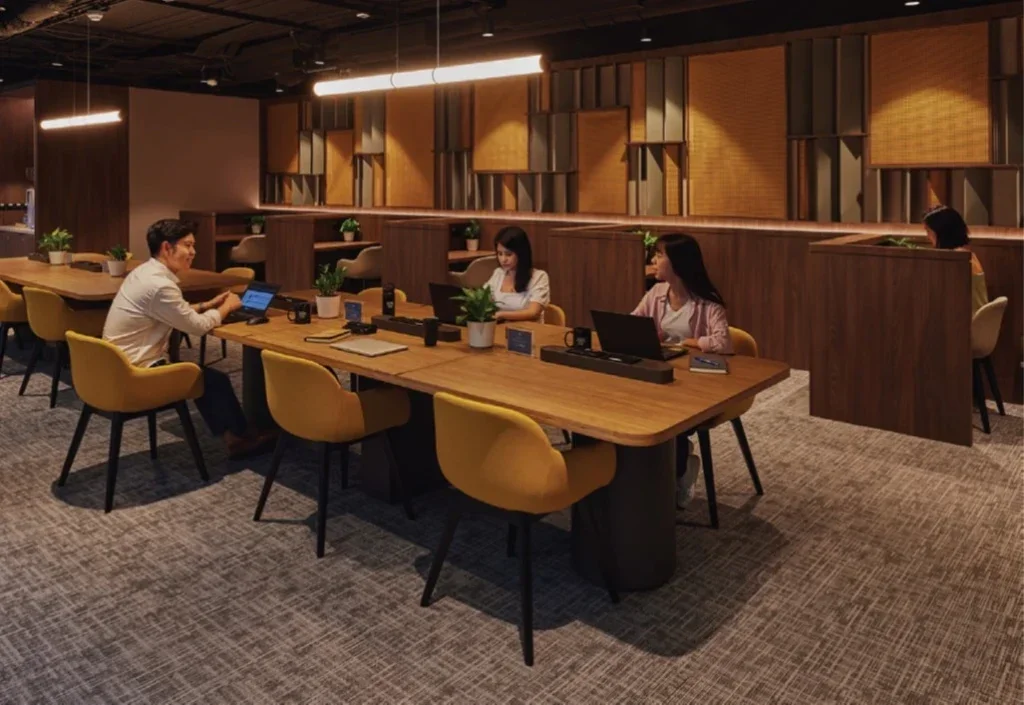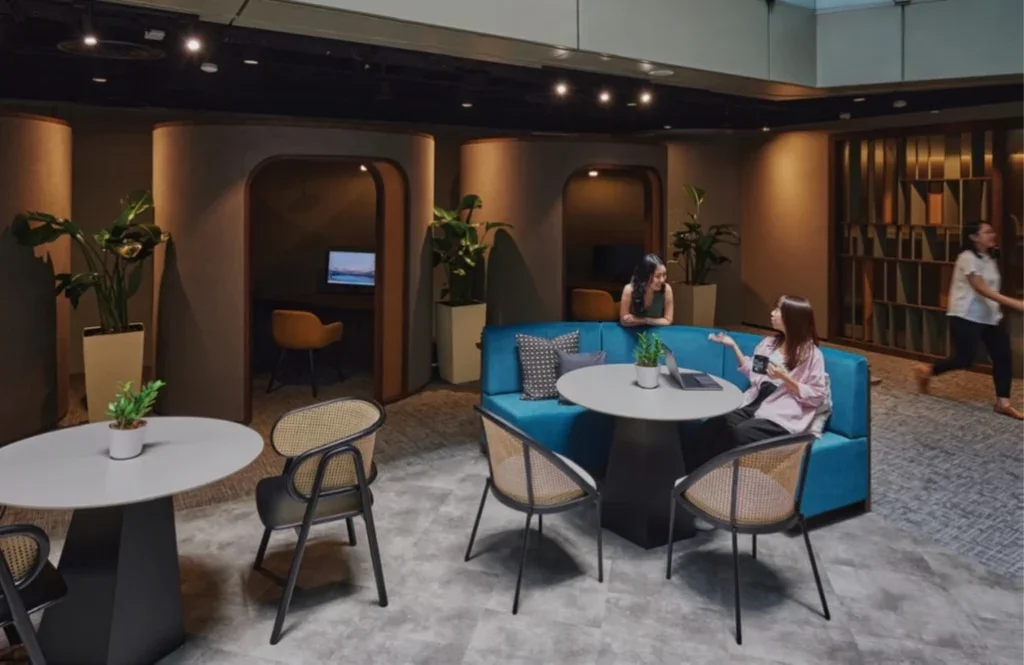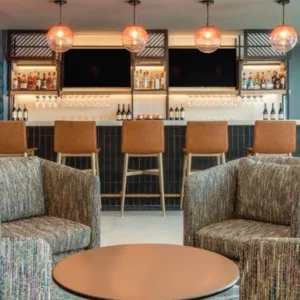
In recent years, airports have evolved from mere transportation hubs into multifaceted ecosystems designed to cater to the diverse needs of modern travellers. Among the many amenities offered, co-working spaces within airport terminals have gained considerable traction, providing a haven for remote workers, business travellers and digital nomads alike.
The emergence of co-working spaces within these hubs can be attributed to the evolving nature of work and travel post-pandemic, where the world learned to work without a traditional office. With the rise of this new remote workforce and the increasing prevalence of digital nomadism – where a section of the workforce believes their work can be done anywhere in the world as long as they have a laptop – travellers are seeking convenient and productive environments to work while on the go. While WeWork may have flown too close to the sun, other commercial entities and transport terminals have stepped into the arena with their own roll of the dice on shared work stations.
Airport authorities and operators in particular have responded to this demand by incorporating co-working areas into their terminal designs, recognising the potential to enhance the passenger experience and capitalise on a growing market segment.
In 2018, PowWowNow released a survey of the best airports for remote working, which saw Narita International in Tokyo and Suvarnabhumi Airport in Bangkok come out on top, closely followed by Moscow Sheremetyevo and Singapore Changi Airport (more on there later), while Leonardo Da Vinci Airport in Rome and London Heathrow were the best in Europe.
However, the pre-pandemic world was very different to the one we live in today. Demands have changed. We are no longer just talking about Wi-Fi hotspots.
Leaders of the pack
Amsterdam Airport Schiphol is one of Europe’s busiest airports. The co-working space at Schiphol is one of the better examples of the integration of modern workspaces into traditional transit environments.
The Sheraton Club Lounge offers a range of amenities, including high-speed Wi-Fi, comfortable seating and business services, catering to the needs of discerning travellers requiring a temporary workspace between flights.
“The Spaces Lounge at Schiphol Airport is a good example of the work we are doing to provide highquality hybrid workspaces where people need them,” Mark Dixon, CEO of IWG, which operates Spaces, emphasised to Skift when it opened.
Other airports with notable facilities include the Urban Cowork Airport Lounge at Sãu Paulo International, Their Patio at Dubai International Airport, and Jabbrrbox’s Booths at US airports.
But do they go beyond the ‘lounge’ experience? Pushing boundaries beyond a charge point and a coffee to present something far more accommodating?

In perhaps one of the best examples of embracing the hybrid-working world, JustCo, Asia’s flexible workspace provider, set its sights on a venture in partnership with Changi Airport Group (CAG). Their collaborative effort brought forth a ‘pay-per-minute’ co-working hub within the confines of Changi Airport Terminal 3 (T3), marking a significant evolution in the co-working model airports may have traditionally been looking at.
In the wake of the pandemic’s ebb and the resurgence of travel and in-person engagements, JustCo’s aim was to redefine the notion of remote work with its concept of 24/7 access to co-working spaces, a ‘nap zone’ and an array of culinary options.
Unveiled in the fourth quarter of 2023, JustCo Changi Airport T3 showcases round-the-clock accessibility and a hot-desking facility boasting close to 50 workstations. Designed with travellers’ transient needs in mind, its pay-per-minute pricing model allows flexibility for individuals requiring workspace for varying durations, be it hours or mere minutes between flights.
Beyond hot-desking, the centre features private office suites, work lounges, meeting rooms with video conferencing tools and collaborative zones, catering comprehensively to the diverse work modalities of nomads and traditional business travellers alike.
It is perhaps the importance of well-being amid hectic travel schedules, that encouraged the centre to include its nap zone, furnished with partitions for tranquillity and a pantry stocked with food vending machines for quick bites. These lifestyle and wellness facilities aim to enhance the overall work experience and productivity of travellers constantly on the move. Something millennials and the Gen Z workforce place as a high priority.
“JustCo’s new partnership with CAG will reinvent the work-life harmony experience for frequent business travellers and digital nomads. We are offering a convenient and cost-effective workspace solution to travellers and patrons of Changi Airport, regardless of their length of stay,” Kong Wan Long, co-founder and chief commercial officer of JustCo, said at the launch of the partnership.
Echoing this sentiment, Lim Peck Hoon, executive vice-president for commercial at CAG, emphasised the significance of this collaboration in enhancing Changi Airport’s offerings. “The introduction of the JustCo centre within Terminal 3 is part of our ongoing efforts to refresh and enhance our offerings for our customers to further enrich their airport experience,” she stated.
Assessing effectiveness
To evaluate the effectiveness of these airport co-working spaces, it is essential for operators to consider various factors that contribute to their usability and impact on travellers. The below can perhaps be viewed as the essential criteria to satisfy the requirements of the modern mobile worker:
- Accessibility: Co-working spaces should be strategically located within airport terminals to ensure easy access for travellers. Ideally situated near departure gates, lounges, or transit areas, well-placed co-working spaces maximise convenience and utilisation among passengers with varying itineraries and time constraints.
- Facilities and amenities: The quality and availability of facilities and amenities play a crucial role in shaping the co-working experience at airports. Essential amenities such as reliable Wi-Fi, printing services, ergonomic seating and refreshments contribute to the overall comfort and productivity of users, distinguishing premium co-working spaces from standard waiting areas. The integration of private meeting rooms and high-speed internet connectivity, reflects a commitment to providing comprehensive solutions for business travellers.
- Ambiance and productivity: An environment conducive to work is paramount for maximising productivity and satisfaction among users. Co-working spaces within airports should offer a balance between functionality and comfort, providing adequate lighting, minimal distractions and ergonomic furnishings to facilitate focused work sessions and business activities. The incorporation of design elements that promote relaxation and concentration, such as ergonomic seating and noise reduction measures, enhances the overall co-working experience.
- Cost and accessibility: The accessibility and affordability of co-working spaces within airports vary depending on the airport’s pricing model and passenger demographics. While some airports offer co-working spaces as part of premium lounge access or membership programmes, others provide them as complimentary amenities for all passengers, ensuring inclusivity and accessibility for travellers of diverse backgrounds and budgets. The availability of flexible pricing options and membership plans, caters to the needs of different traveller segments, fostering greater accessibility and utilisation.

Impact and future outlook
The provision of co-working spaces within airport terminals should represent a significant evolution in airport design and passenger service offerings. By catering to the needs of modern travellers seeking connectivity and productivity on the go, airports can enhance their competitive advantage and position themselves as hubs of innovation and convenience in the digital age.
The impact of airport co-working spaces extends beyond mere functionality, influencing passenger perceptions of airport quality and contributing to overall satisfaction and loyalty among travellers.
As remote work continues to proliferate and the demand for flexible workspaces grows, the importance of airport co-working spaces is expected to increase significantly in the coming years.
Airport authorities and operators must continue to innovate and adapt to changing traveller preferences and technological advancements, ensuring that co-working spaces remain relevant and effective in meeting the evolving needs of passengers worldwide.
Amsterdam and Changi highlight the effectiveness of well-designed co-working spaces in enhancing the passenger experience, fostering productivity, and facilitating seamless travel transitions.
By focusing on accessibility, amenities, ambiance and affordability, airports can create dynamic work environments that resonate with the demands of today’s discerning travellers, ultimately solidifying their position as key players in the global travel landscape and fuelling corporate blog posts for years to come.






